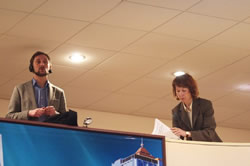Conference report
The 13th meeting of the Goose Specialist Group has been held from from Thursday 24 March to Tuesday 29 March 2011 in Elista, Kalmykia (Russian Federation).
From Thursday 24 March to Tuesday 29 March 2011 the 13th meeting of the Goose Specialist Group of the IUCN-SSC was held in conjunction with the 4th meeting of the Russian Goose, Swan and Duck Study Group (GSDSG) of northern Eurasia in Elista, Kalmykia (Russian Federation). back to meetings
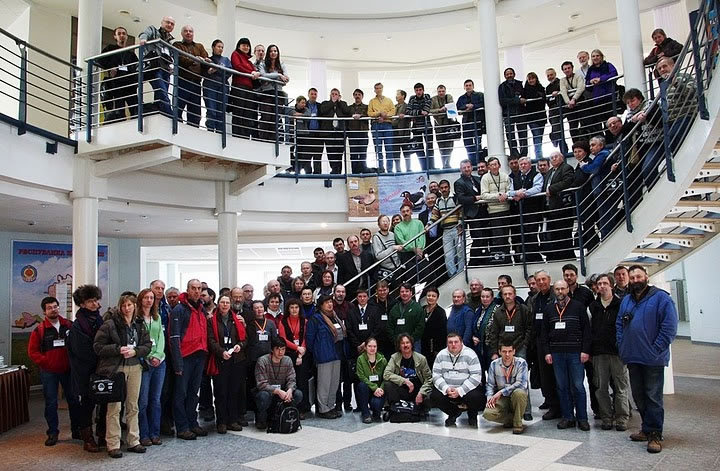 |
| Participants Waterfowl conference Elista March 2011 (©Vladimir Melnikov) |
This conference WATERFOWL OF NORTHERN EURASIA, GEOGRAPHY, POPULATION AND ENVIRONMENTAL DYNAMICS AND POPULATION MANAGEMENT was attended by 140 participants from 18 different countries: Australia (1), Belarus (1),Belgium (2),Bulgaria (3),Czech Republic (1), Finland (2), France (2), Germany (3), Hungary (1), India (3), Kazakhstan (1), Latvia (1), Netherlands (7), Norway (1), Russian Federation (99), the United Kingdom, (2), Ukraine (7), and the United States of America (3). Only the participants from China unfortunately had problems in getting their visas arranged in time, and therefore were not able to attend this meeting.
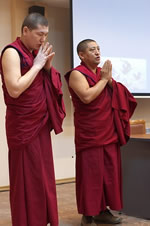 |
The conference was opened and blessed by two Bhuddist monks (lamas) from the Central Khurul of Kalmykia in Elista. |
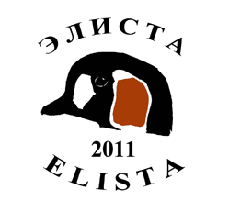 |
| Blessing of the conference (©Vladimir Melnikov) |
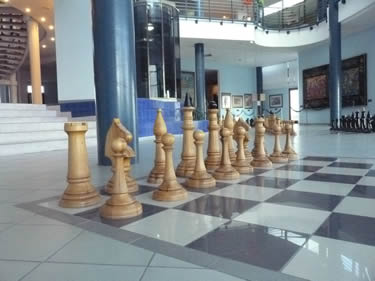 |
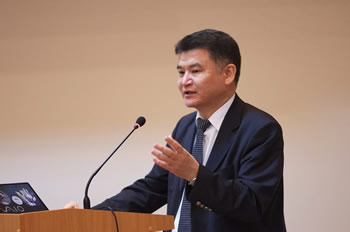 |
| Chess City Conference Hall (© Doortje Dallmeijer) |
Vyacheslav N. ILYUMZHINOV, |
Vyacheslav Nikolaevich ILYUMZHINOV, the First Deputy Prime Minister of the Republic of Kalmykia was impressed that so many people from so many countries gathered in their excellent conference hall in Chess City in Elista. On the website http://www.kalmpriroda.ru/n58.html of the Republic of Kalmykia a special news item was dedicated to this conference.
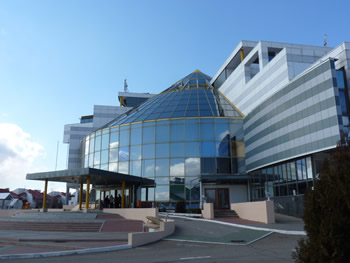 |
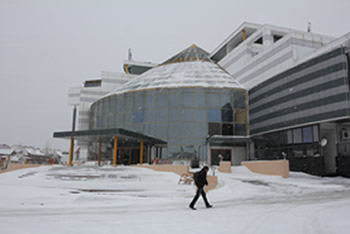 |
| Conference hall in Chess City before and after snowfall during the conference(©Doortje Dallmeijer) | |
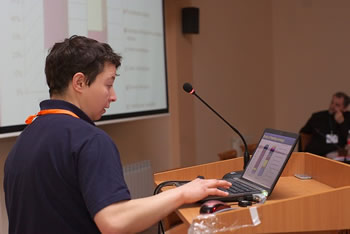 |
Sonia Rozenfeld and Petr Glazov initiated the plan to hold this joint meeting in Elista during the previous GSG-meeting in Höllviken, Sweden, and this plan was endorsed by the late chairman of the GSDSG Nikolay Poyarkov, Yevgeny Syroechkovskiy (current chairman of the GSDSG) and Konstantin Litvin, the liaison person between the GSG-board and the GSDSG. |
| Sonia Rozenfeld (©Vladimir Melnikov) |
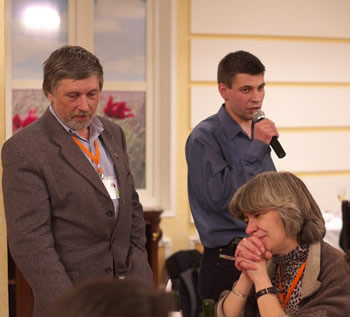 |
Sonia Rozenfeld and Petr Glazov (conference secretary) and the organization Monomax Congresses and Incentives from St.Petersburg were responsible for the local organisation and all practical arrangements. The organizing further consisted of Arkadiy A. Tishkov, Konstantin E. Litvin, Vladimir V. Morozov, Olga B. Pokrovskaya, Anastasia B. Popovkina, Olga Yu. Anisimova and Elmira M. Zaynagutdinova. The local committee was chaired by Victor Badmaev (of the “Chernye Zemli” Nature Reserve in Kalmykia) |
| Konstantin Litvin, Petr Glazov and Anastasia Popovkina (©Vladimir Melnikov) |
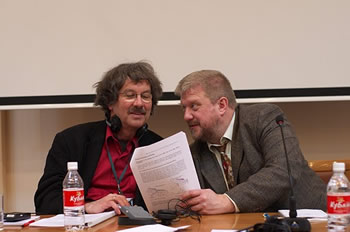 |
The conference was jointly chaired by Yevgeny Syroechkovskiy (on behalf of the GSDSG) and Barwolt Ebbinge (on behalf of the GSG) and Vladimir Miroshnichenko (on behalf of the Kalmykian Ministry of natural Resources, Environment Conservation and Energy Development). |
| Chairmen Barwolt Ebbinge and Yevgeny Syroechkovskiy (© Vladimir Melnikov) |
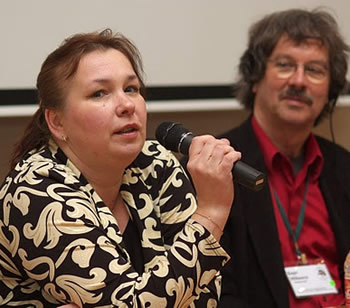 |
Monomax Congresses and Incentives developed a special website for registration and information, organized all logistics, and arranged for simultaneous translation from Russian to English and vice versa during the conference. The two interpreters really did a great job and skilfully translated all presentations and lively discussions.
|
| Julia Rayskaya of Monomax Congresses and Incentives (© Vladimir Melnikov) | The interpreters on their balcony (© Vladimir Melnikov) |
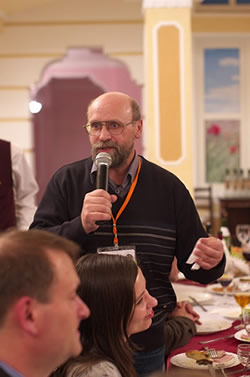 |
| Aleksandr Kondratyev ( © Vladimir Melnikov) |
The scientific programme was in the capable hands of a team chaired by Aleksandr (Sasha) Kondratyev, and apart from presentations about the distribution, flyways, abundance and systematics of waterfowl, also special symposia were held on hunting and game management, on waterfowl in arid ecosystems and on the impact of growing biofuels and land use change on waterfowl habitats. All in all during the four conference days there were 92 oral presentations and 27 poster presentations.
Because many Greater White-fronted Geese and Red-breasted Geese, that winter around the Black Sea migrate in spring through Kalmykia to their Siberian breeding grounds special focus was on these two species. Moreover, smaller but important numbers of Lesser White-fronted Geese also pass through Kalmykia. As one can see in the Abstract book not only geese, but also swans and ducks featured in the many presentations. Problems with illegal hunting were extensively addressed as well as the topic of legal spring hunting, and how this could be restricted in order to safeguard the future of migratory goose populations.
It was striking that three independent presentations from three different sites on the Taimyr peninsula all indicated an expansion of the breeding range of red-breasted Geese, whereas the midwinter counts of this species show a decline. Here clearly more research and improved mid-winter surveys are needed to clarify whether indeed Red-breasted Geese are declining, or that simply many Red-breasted Geese are overlooked, because they have shifted their wintering sites once again.
Several contributions dealt with the wealth of resightings that are now accumulating through network of observers that use the website www.geese.org of neck-banded Greater White-fronted Geese. The precarious situation of the seriously declining population of Taiga Bean Geese was high-lighted.
Finally a resolution was adopted to address all these topics and call for better protection of migratory geese and improved regulation of hunting in Russia.
Numbers of staging geese in Kalmykia in March 2011.
Immediately after the conference (on 30-31 March 2011) Sonia Rozenfeld made an aerial survey over the whole area of Kumo-Manytch depression in Kalmykia and counted 90 000 Greater White-fronted Geese, 26 000 Red-breasted Geese, 840 Lesser White-fronted Geese and 11 500 Greylag Geese. Additional information from the Thograysky reserve in the Stavropol district (to the west of Kalmykia) indicated that about 15 000 Red-breasted Geese were staging in this area in late March, which would bring the total number of staging Red-breasted geese in this area to 41 000.
The proceedings of the conference will be published as three separate volumes of the Russian journal Casarca, one volume with the papers dealing with Red-breasted Geese, one with all other English papers, and one with the Russian papers. All speakers are kindly requested to submit the full text of their presentations before 1 June 2011 to Anastasia Popovkina, who also edited the Abstract book together with Marjorie Bousfield.
Please send your submission before 1 June 2011 to the following e-mail address: goosegroup@gmail.com
The conference was sponsored by the partnership between Wetlands International and Shell, by the INNO-fund of WWF-NL, by the Dutch Faunafund, and by the US Fish and Wildlife Service and by the Russian Foundation for Basic Research. We are extremely grateful for this support.
On the Russian website a foto gallery by Vladimir Melnikov can be found illustrating the excellent atmosphere during the conference. There also all abstracts of the many interesting papers can be found can be downloaded. The list of participants can be downloaded here.

Out of the 8 GSG-board-members the following 5 were present in Elista: Barwolt Ebbinge, Johan Mooij, Ingunn Tombre, Konstantin Litvin, and Thomas Heinicke (© Vladimir Melnikov, Doortje Dallmeijer and Gerard Müskens)
White-fronted Goose Gyula from Hungary
A special surprise during the conference was the appearance in Kalmykia of the White-fronted Goose Gyula, which was mounted with a satellite transmitter in Hungary this winter by Gerard Müskens and Márta Ferenczi. On 25 March this bird made a sharp turn and headed straight for Elista (in the red circle) during the conference (see maps below).
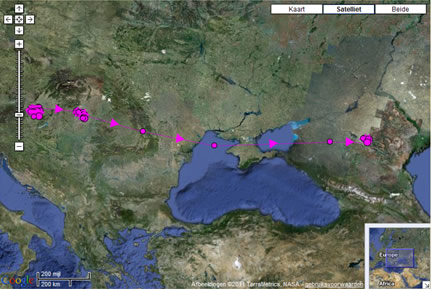 |
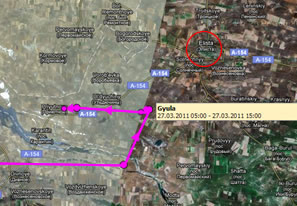 |
| Route of White-fronted goose Gyula (www.blessgans.de) | Gyula in Kalmykia |
Gyula left Hungary on 23 March to reach Kalmykia on 25 March 2011
On 28 March he flew back again heading westward to Manytch Lake to stay there until 6 April 2011. The decision to turn westward again was most likely initiated by the fresh snowfall which turned Elista completely white again during the conference. On 7 April Gyula resumed his spring migration headin NE again, flying over Elista, the staging again from 7- 10 April near Ar-Nur in northern Kalmykia, and his last signal was on 11 April when already flying over NW-Kazakhstan (see www.blessgans.de )
Post-conference excursion
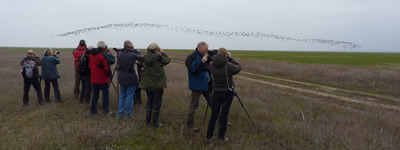 |
| Excursion participants and White-fronted and Red-breasted geese near Manych Lake ( © Barwolt Ebbinge) |
After the conference a small group of 14 participants took part in a post-conference excursion, which allowed them to see the vast steppes of Kalmykia and the adjacent Astrakhan district in more detail, as well as the huge Volga Delta.
At first Divnoe at the Manych Lake was visited. White-fronted Geese and Red-breasted Geese were seen in large flocks, but also two species of Pelican, Garganey, Wigeon, Smew, Great Black-headed Gulls, Slender-billed Gulls, Pochard, Red-crested Pochards, Goldeneye, Ferruginous Ducks,Lapwings, Curlew, Ruff, Shellduck, White-headed Ducks, and Bluethroats were observed.
Impressive was the large number of migrating Pallid Harriers and hundreds of Little Bustards and several Imperial Eagles.
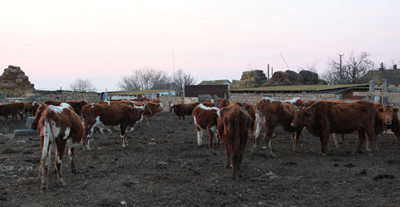 |
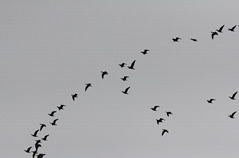 |
| Cattle near a village in Kalmykia © Doortje Dallmeijer |
A flight of Red-breasted Geese© Doortje Dallmeijer |
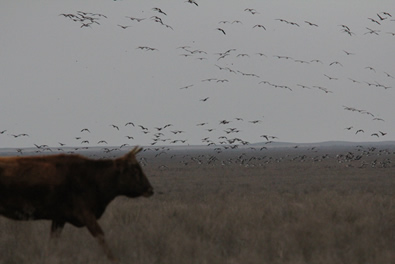 |
|
Cow and White-fronted Geese in Kalmykia (©Doortje Dallmeijer) |
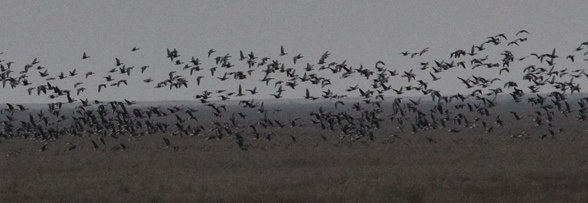 |
| White-fronted Geese and some Red-breasted Geese near Yashkul (©Doortje Dallmeijer) |
Thereafter we went to stay for two days in the Saiga Breeding Center in Yashkul, and visited the vast steppes around this fairly isolated farm. During this trip at least 10 000 Greater White-fronted Geese were carefully checked for neckbands, but none were found. Another proof that most of the Greater White-fronted Geese that stage in Kalmykia do not winter in western Europe, where most of the Greater White-fronted Geese have been marked with neck-bands. Among the Greater White-fronted Geese several tens of Red-breasted Geese were found and at least 10 different Lesser White-fronted Geese.
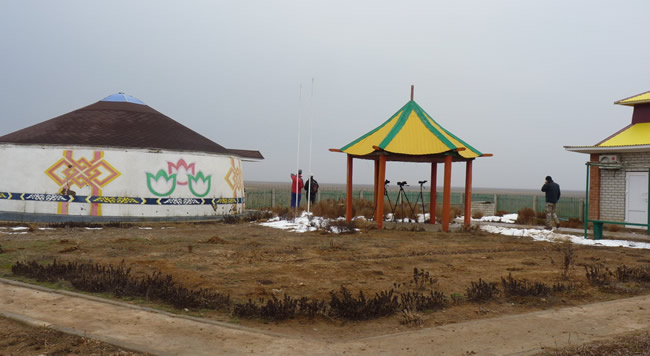 |
| The Saiga breeding farm near Yashkul (©Doortje Dallmeijer) |
The re-introduction programme of the once very numerous Saiga antelopes near Yashkul was very informative. It is incredible how large scale poaching driven by a strong demand from China for Saiga horns has almost wipe out this antelope species.
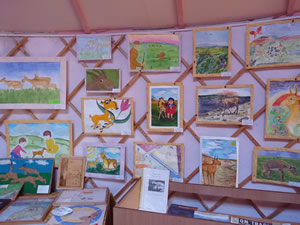 |
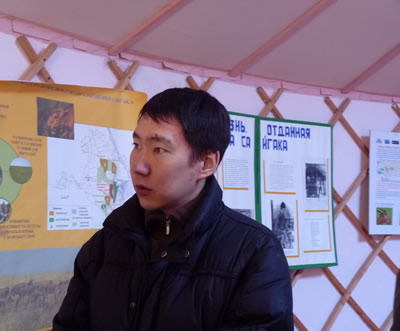 |
| Information about the Saiga breeding programme (©Doortje Dallmeijer) | |
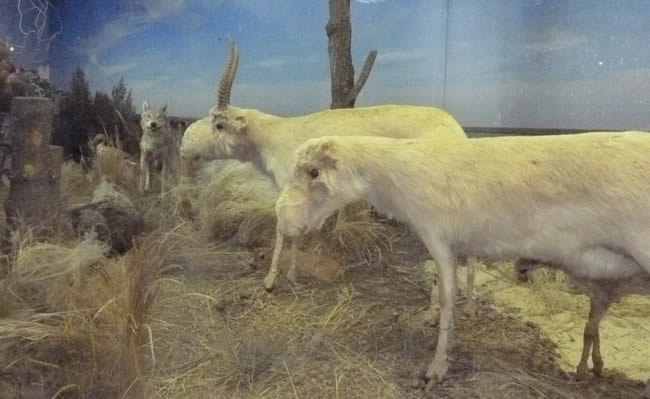 |
|
Exhibition of stuffed Saiga in museum (©Doortje Dallmeijer) |
Finally we left Kalmykia to visit the neigbouring Stepnoy Reserve near Liman in the Astrakhanskiy oblast.
Here we saw again large flocks of hundreds of Little Bustards, many raptor species (including Pallid Harriers, White-tailed Eagles, Long-legged Buzzards, Step Eagles), thousands of Calandra larks, Ruddy Shellduck and tens of pairs of Demoiselle cranes.
In the Stepnoy reserve tracks of wild saiga as well as two live animals were observed, and we were shown how a well-equipped anti-poaching team tried to stop poaching in this vast reserve. Moreover several foxes were seen, one wolf and some suslik. In the dark in the headlights of our cars also many kangaroo rats were seen.
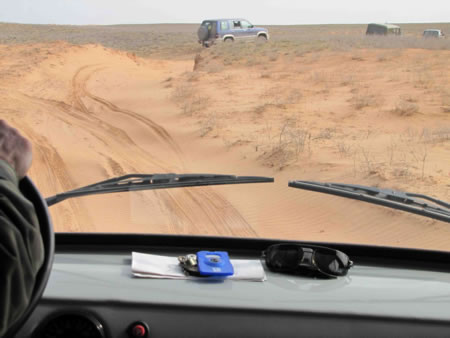 |
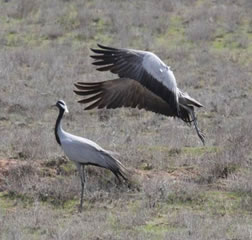 |
| Excursion in the Stepnoy Reserve (breeding habitat of Demoiselle Cranes) (©Gerard Müskens) |
Pair of Demoiselle cranes (©Doortje Dallmeijer) |
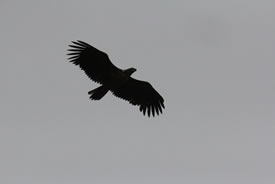 |
|
White-tailed Eagle (©Doortje Dallmeijer) |
The excursion ended in Astrakhan where we visited the reserve in the Volga Delta. During a windy trip in small boats we saw Night herons, White-tailed Eagles, Caspian terns, Whooper Swans in this vast delta.
Report by Bart Ebbinge (Alterra, Wageningen (NL), Chairman of the Goose Specialist Group.
